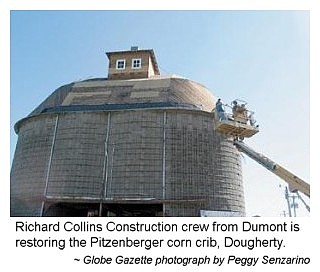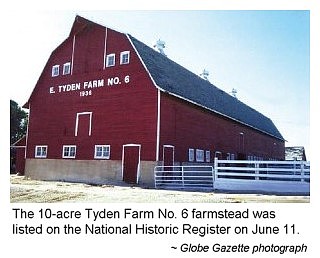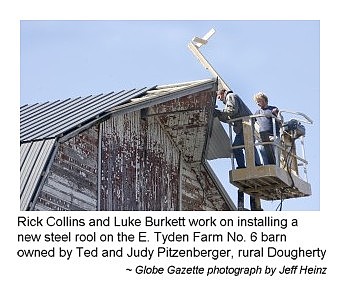


Cerro Gordo County Iowa
Part of the IaGenWeb Project
|
The Globe Gazette
 DOUGHERTY — Ted and Judy PITZENBERGER feel a responsibility to history. That is why the project to restore a massive corn crib on their farm, thought to have been built in the mid- to late 1930s, is so important to them. Their farmstead, known as Emil TYDEN No. 6, was one of eight Dougherty-area farms built and owned by TYDEN, a Swedish immigrant. TYDEN made his fortune through mechanical inventions and in 1915 decided to invest in agriculture in North Iowa. "It was a dream," Judy PITZENBERGER said. "I've wanted that corn crib fixed up since we moved here. It just kept getting into worse shape and I really thought we were going to lose it." Then the Iowa Barn Foundation stepped in with a $10,000 matching grant. The corn crib was built by the Waterloo Concrete Co. The PITZENBERGERS are unsure of the exact year it was constructed. The corn crib measures 150 feet around and 50 feet high. "They were built to hold ears of corn. They were so massive that they never built a lot of them," Ted said. It was made of fir, not pine, which the PITZENBERGERS said contributed to its longevity. The TYDEN corn crib had an elevator inside. It has six overhead bins and two side bins. It can hold 22,000 bushels of corn, according to Ted. "This is hers," Ted joked about the corn crib. "I call it 'Judy's folly.' I hadn’t a clue," she quipped. The restoration work is being done by Richard COLLINS Construction of Dumont. "Back when it was built, these guys did all the work with a hand saw," COLLINS said. This is the third corn crib of this design which COLLINS has renovated. The PITZENBERGERS are also hoping to get the barn, which needs a new roof, on the National Register of Historic Places. The designation would help the project qualify for grant money. The cost of a new roof for the barn is estimated at $50,000 to $60,000. "The neighbors all think it's wonderful. They're talking about all these buildings getting lost," Judy said. "We're losing too much of our heritage.” Ted said. "We feel it's an honor to be associated with it." The barn measures 40 feet by 140 feet with an attached L-shaped cattle shed which also measures 40 by 140 feet. The barn can hold 25,000 bales of hay. "It could take them in from both ends. It had a pulley system to pull the hay into the haymow," Ted said. The barn, which was built in 1936 for beef cattle, was also equipped with its own electric winch. "We feed hogs in it now," Ted said. The barn cost $1,500 when it was built, Judy said.
DES MOINES — Eleven barns around North Iowa will be open to the public during a self-guided barn tour set for Saturday and Sunday, Sept. 22 and 23. The barns, most of which have been restored with matching grants from the Iowa Barn Foundation, will be open from 9:30 a.m. to 5:30 p.m. The event will feature a total of more than 70 historic barns across the state. The barns in North Iowa which are on the tour include: DREYER Barn: 102 310th St., Fenton (Kossuth County). From the south side of Fenton, turn west on County Road B-19. Go ¾ of a mile west to the second place on the south side of the road. The farm has been in the family since 1900. The barn was built in 1903 and used as a dairy barn until 1944. There is a 1,000-gallon wooden water storage tank in the hay loft. The manure unloading system is intact. GADE BARN: 301 230th St., Whittemore (Kossuth County). From Algona, go west to the corner of U.S. Highway 18 and Iowa Highway 15. Go north one mile on Highway 15, then east on the gravel and down a hill. The farm is on the left. Arnold and Martha GADE bought the farm in 1921 for $3,000. WEGENER Barn: 109 320th St., Fenton (Kossuth County) The barn is one-half mile north of Fenton on Iowa Highway 15. It is the first place going west. Neighbors helped build this magnificent double gambrel barn for a farmer's widow in 1915. HAUGEN Barn: 18446 420th St., Leland (Winnebago County) Go three miles north of Leland on U.S. Highway 69 to 420th Street. Turn right onto 420th. The farm is the first place on the north side of the road. 420th Street is gravel. The barn was built in 1915. In 1924, Peter HAUGEN enlarged it using a hand saw to split the barn in two. He added a section to the middle. TENOLD BARN: 43567 Wheelerwood Road, Northwood (Worth County) Exit Interstate 35 at the Kensett/Joice exit. Go ¼ mile west to Wheelerwood Road. Turn north and travel 2½ miles. The barn is across from what was the town of Tenold on the Iowa map until 1960. ROCKAFELLOW BARN: 4484 Echo Avenue, St. Ansgar (Mitchell County) Go two miles north of St. Ansgar on U.S. Highway 218. Turn left at Echo Avenue. Beautiful bank barn with a limestone foundation. The barn was built in 1877 for horses and cattle. The timber was framed with wooden pegs. BLAKE BARN: 11670 300th Street, Mason City (Cerro Gordo County) Go two miles north of Mason City on Iowa Highway 65. Take a left onto County Road B-20. Go four miles west on B-20. The farm is on the north side of the road. YEZEK BARN: 22881 Vine Avenue, Plymouth (Cerro Gordo County) From Rock Falls, go one mile north on the county blacktop. The barn is on the east side of the road. This 32-foot by 32-foot barn with a metal cupola was built in 1930 and is one of the only barns still standing in the area. The barn was in vulnerable condition when the YEZEKS started the restoration project. BENNETT BARN: 1664 Eagle Avenue, Latimer (Franklin County) Take Interstate 35 to Iowa Highway 3. Turn west on Highway 3 and go one mile to Eagle Avenue. Turn north and go 2½ miles. This handsome clay tile barn, with a round, laminated rafter roof, was built in 1950 by Henning Construction Company of Latimer for a dairy herd. KLOUSI BARN: 1766 165th Street, Hampton, (Franklin County) At the intersection of Iowa Highway 65 and Iowa Highway 3 in Hampton, turn east and go two miles. Then travel north for two miles and finally go west a ¼ mile to the barn. The barn is of peg construction and sits on a hill on a gorgeous farmstead. The owner copied a Wisconsin dairy barn when he built it in 1888. The barn was proudly placed on the most prominent position on the farm. DODD BARN: 1854 40th street, Ackley (Franklin County) Travel four miles west of Ackley on Iowa Highway 57. Go two miles north on County Road S-55 to 40th Street. Then go ½ mile west on 40th Street. The barn was built by Ernest ALDINGER, one of three ALDINGER Brothers who built farms within a mile of each other. The Iowa Barn Foundation, an all-volunteer, non-profit organization, raising money only from individuals, foundations and corporations to give matching grants to property owners to restore their barns. The property owner must sign a perpetual easement when receiving a grant. The foundation sponsors a spring barn tour and publishes a semi-annual magazine. The purpose of the tour is to encourage barn preservation in the state and to teach young people about Iowa's rich agricultural heritage.
The Globe Gazette
 DOUGHERTY — A historic North Iowa farmstead is soon to be the subject of a TV documentary. Listed as TYDEN Farm No. 6 and owned by Ted and Judy PITZENBERGER, the 10-acre farmstead was listed on the National Historic Register June 11, Judy PITZENBERGER said. "In celebration of this designation, work has started on a documentary to be finished in September," she said. The film will document the farm and its history, including information about Emil TYDEN, the Swedish immigrant who purchased and developed the farm in the early 1900s. The PITZENBERGER farm is one of eight Dougherty-area farms TYDEN developed. Born in 1865, he emigrated to the United States in 1885 at the age of 19. TYDEN lived and worked in Chicago, eventually working for the Union Pacific Railroad. In the 1890s he invented the cargo seal for railroads and shipping companies to deter cargo theft and pilferage. The product he invented, the TYDEN Ball Seal, was manufactured at TYDEN'S International Seal and Lock Co., located in Hastings, Mich. Reportedly distrustful of the stock market, TYDEN began purchasing farmland in the Dougherty area in 1915 as an investment, according to newspapers of the time. He leased the land to local farmers to work. "During the Depression, he did so much good for people by giving them jobs," PITZENBERGER said. During the 1930s and 1940s, TYDEN visited farmstead No. 6 to see how things were going, PITZENBERGER said. He stayed in a back bedroom of the farmhouse, with its own stairway to the kitchen. The PITZENBERGERS purchased Farm No. 6 in 1994 from descendants of Emil TYDEN. In 2007, the PITZENBERGERS restored the massive corn crib, thought to have been built in the mid- to late-1930s. They hope to also replace the roof of the 140-by-40-foot barn. "We felt we needed to do something in honor of (TYDEN)," PITZENBERGER said. "The farming history's really important, too, and we’re losing a lot of that."
The Globe Gazette
 DOUGHERTY — North Iowans got a glimpse of old farming and new farming techniques during the Mason City Agribusiness Committee and Cerro Gordo County Farm Bureau third annual farm tour. The tour, held Thursday to educate people about rural Iowa, was at the Emil TYDEN Farm No. 6 near Dougherty. Ted and Judy PITZENBERGER own the farm and have been restoring it to its 1936 look. "I didn’t know there was something like this this close to Mason City," said Bob THOMAS, Mason City, who went on the tour with about 30 other people. TYDEN, a Swedish immigrant, owned several farms around the Dougherty area but built No. 6's barn, corn crib and small machine shed in 1936. The Sears house was built before then and other buildings were added over the years. The tour included a look at the farm's buildings and a biofilter, which was the modern aspect of the tour. In the house the PITZENBERGERS explained what each room was used for, where TYDEN slept and showcased Judy and Ted's many family heirlooms. "My daughter is convinced I have something worth a lot," Judy said during the tour. "I say, 'No it's just family heirlooms.'" Some included Judy's grandparents' bedroom set, her grandma's christening gown and her mother's graduation dress. The PITZENBERGERS have also restored some aspects of the house to a 1930s look, including the stove and a toilet with a pull chain. The home was also complete with a summer kitchen. It was used for washing, baking and anything else the family didn't want to warm up the house during the summer months. During the tour of the outdoor buildings Ted explained that around 80 people helped construct the corn crib, barn and shed. "He did a lot of good things around here during the Great Depression," he said. The corn crib, made out of concrete, is 150 feet around and 50 feet tall with an elevator inside. The barn is 40 by 140 feet and can hold 25,000 square bales of hay. The PITZENBERGERS replaced the corn crib roof last year and plan to replace the barn roof some day. "There are certain things we think should be kept," explained Ted as to why they're restoring the farm. "This place needs to be preserved for agriculture history in Iowa." Old machinery and tools could be found displayed as well. At the biofilter site it was explained that wood chips placed underground near Cold Water Creek help filter out nitrogen, which is causing the Cedar River to be on Iowa’s impaired waters list. The creek water eventually ends up in the Cedar River. The filter is one of three of its kind in Iowa. The tour ended with a supper and history of the TYDEN farms. "I think it was awesome," said Kim SVEJDA, Mason City. "It's amazing the memories that can be passed on through the generations." Gary HALL, Cerro Gordo County Extension director and agribusiness committee member, was impressed how far farming technology has come over the years. "It begs the question, ‘What are we going to see over the next 50 years?'" he said.
The Globe Gazette
 DOUGHERTY - Judy and Ted PITZENBERGER are hoping that if they preserve it, you will come. Starting next summer, the couple plan to offer tours of their farm, TYDEN Farm No. 6, near Dougherty. The property established around 1936 is listed on the National Register of Historic Places. Col. Emil TYDEN built eight farms in North Iowa, all during the Great Depression. The Dougherty property includes a big red barn, corn crib, summer kitchen and gardens. "It's just so neat to see the old (buildings) be here and see so many people that are interested in it," Judy said. "It makes us feel good about what we are doing." Born in 1865, TYDEN emigrated to the United States in 1885 at the age of 19. TYDEN lived and worked in Chicago, eventually working for the Union Pacific Railroad. In the 1890s he invented the cargo seal for railroads and shipping companies to deter cargo theft and pilferage. The product he invented, the TYDEN Ball Seal, was manufactured at TYDEN'S International Seal and Lock Co., located in Hastings, Mich. TYDEN had almost 200 patents by the time he died. Reportedly distrustful of the stock market, TYDEN began purchasing farmland in the Dougherty area in 1915 as an investment, according to newspapers of the time. He leased the land to local farmers to work. During the 1930s and 1940s, TYDEN visited farmstead No. 6 to see how things were going, PITZENBERGER said. He stayed in a back bedroom of the farmhouse, with its own stairway to the kitchen. The PITZENBERGERS purchased Farm No. 6 in 1994 from descendants of Emil TYDEN. In 2007, the PITZENBERGERS restored the massive corn crib, thought to have been built in the mid- to late-1930s. The barn just had a steel roof installed. PITZENBERGER said she decided to have steel roofing installed instead of shingles because of the cost and the longevity of the steel. Shingles for the barn and cattle shed would have run the couple $66,000. "Steel was half the price. This was a no brainer," she said. And the steel roofing will last 50 years or more. The barn roof was leaking badly. The couple plan on turning a portion of the barn into a museum. "We're just so pleased that it looks so nice." She said many people including TYDEN family members and perfect strangers with information, furniture and paperwork detailing TYDEN'S work in Dougherty. "It's like it was just waiting to be discovered," Judy said. They have found home movies of the farm operation and transferred them to DVD. The movies, which were originally shot on 16 mm film, show workers filling silos and feeding cattle and pigs. TYDEN didn't build the house or the summer kitchen. PITZENBERGER thinks the house was built in the late 1910s. They hope to start the tours in July 2011, offering 12 tours a year. The tours would be offered for two weekends in July and another two weekends in August to take advantage of the farm's beautiful gardens. Uncovering the history of the property has become a passion for the couple, especially for Judy. "You can't say no to it. It's been so cool. You just don't know what's going to turn up around the next corner."
Transcriptions by Sharon R. Becker, May of 2011
|
Return to Cerro Gordo Home Page